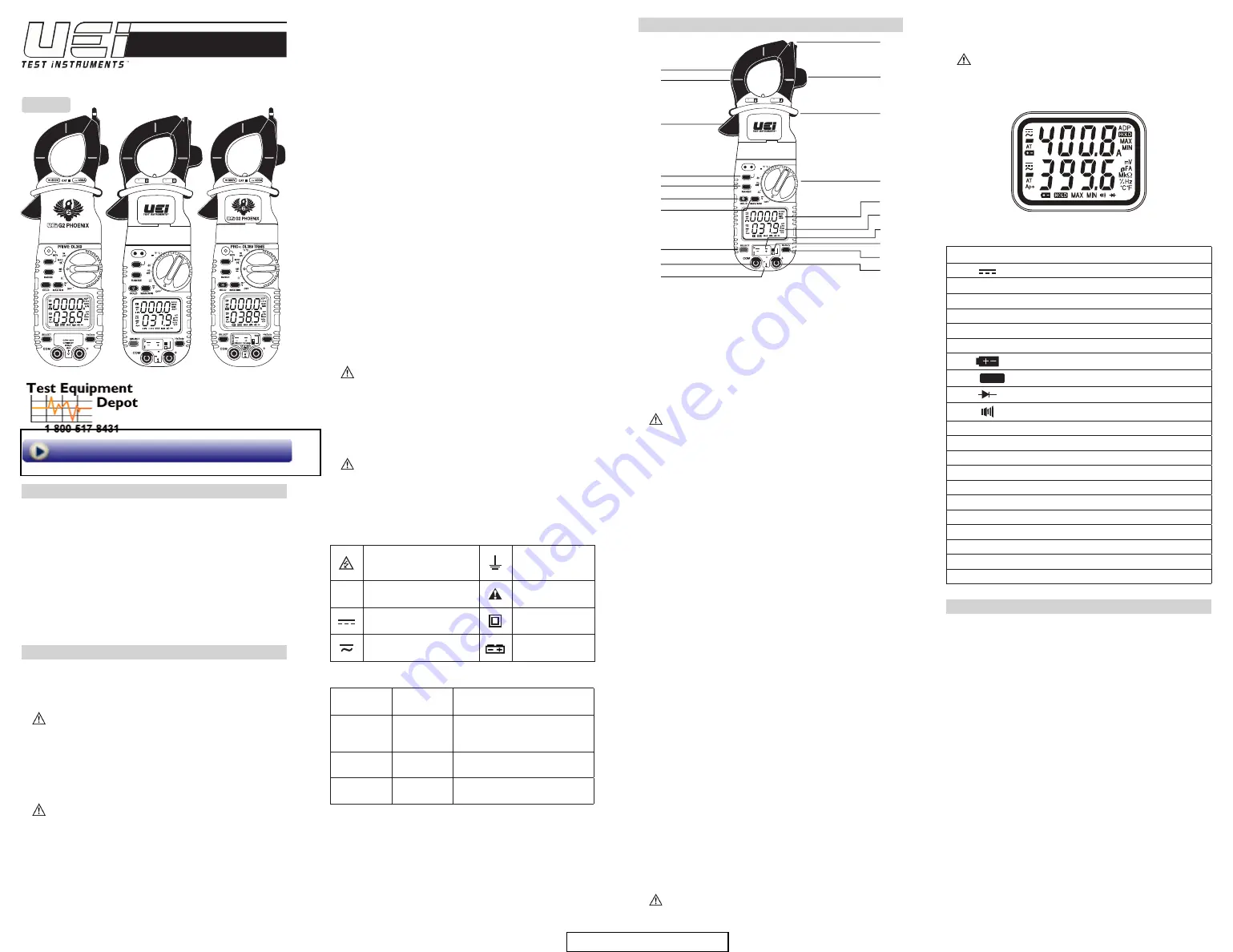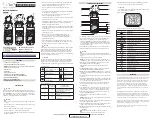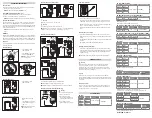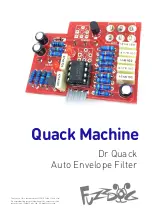
CATIII 600V
CATIV
300V
DISCONNECT TEST LEADS
30V
TEMP
DL379B
Hi-NCV-Lo
MFD
µA
600V
CAT III
400A
INSTRUCTION MANUAL
ENGLISH
DL369/DL379B/DL389
FEATURES
• 3 ¾ digit, 4000 count LCD display
• Auto-ranging with manual ranging capability
• MIN/MAX (Peak Hold). All ranges except capacitance & frequency.
• Frequency, duty cycle, data hold
• Auto power off
• Dual display
• Built-in test lead storage
• Backlit d Worklight (DL379B & DL389)
• Detachable current clamp head (DL379B & DL389)
• Temperature (DL379B & DL389)
• Magnetic mount (DL379B & DL389)
• True RMS measurement (DL389 only)
SAFETY NOTES
Warning
Refer to user guide regarding potential hazard and proper instructions.
Before using this meter, read all safety information carefully. In this manual
the word “WARNING” is used to indicate conditions or actions that may
pose physical hazards to the user. The word “CAUTION” is used to indicate
conditions or actions that may damage this instrument.
Warning
• Before each use, verify meter operation by measuring a known voltage
or current.
• Never use the meter on a circuit with voltages that exceed the category
based rating of this meter.
• Do not use this meter during electrical storms or in wet weather.
• Do not use the meter or test leads if they appear damaged.
• Keep your fingers away from the test lead’s metal probe contacts when
making measurements.
• Ensure meter leads are fully seated and keep fingers away from metal
probe contact when making measurements. Always grip the leads
behind the finger guards molded into the probe.
• Do not open the meter to replace batteries white the probes are
connected.
• Use caution when working with voltages above 60V DC or 25V AC RMS.
Such voltages pose shock hazards.
• To avoid false readings that can lead to electrical shock, replace
batteries if a low battery indicator appears.
• Unless measuring voltage or current, shut off and lock out power before
measuring resistance or capacitance.
• Always adhere to national and local safety codes. Use proper personal
safety equipment (PPE) to prevent shock and arc blast injury where
hazardous live conductors are exposed.
• Always turn off power to a circuit or assembly under test before cutting,
unsoldering or breaking the current path. Even small amounts or current
can be dangerous.
• Always disconnect the live test leads before disconnecting the common
test lead from the circuit.
• In the event of electrical shock, ALWAYS bring the victim to the
emergency room for evaluation, regardless of victim’s apparent
recovery. Electrical shock can cause unstable heart rhythms that
may need medical attention.
• If any of the following occur during testing, turn off the power source
to the circuit being tested: arching, flame, smoke, extreme heat, smell of
burning materials or discoloration or melting of components.
Warning
Higher voltages and currents require greater awareness of physical safety
hazards. Before connecting the test leads; turn off power to the circuit
under test; set meter to the desired function and range; connect the test
leads to the meter first, then connect to the circuit under test. Reapply
power. If an erroneous reading is observed, disconnect power immediately
and recheck all settings and connections.
Warning
This meter is designed for trade professionals who are familiar with the
hazards of their trade. Observe all recommended safety procedures that
include proper lock-out utilization and the user of personal protective
equipment that includes safety glasses, gloves and flame resistant clothing.
Symbol Definitions
Equipment is safe for
connection and disconnection
to Live conductors
Ground
~
AC
Alternating Current
Warning or Caution
DC
Direct Current
Double Insulation
(Protection Class II)
Not Applicable to
Identified Model
Battery
Category Definitions
Measurement
Category
Short-Curcuit
(typical) kA
a
Location in the
building installation
II
< 10
Circuits connected to mains socket
outlets and similar points in the
MAINS installation
III
< 50
Mains distributions parts of the
building
IV
> 50
Source of the mains installation in
the building
CONTROLS AND INDICATORS
CATIII 600V
CATIV
300V
DISCONNECT TEST LEADS
30V
TEMP
DL379B
Hi-NCV-Lo
MFD
µA
600V
CAT III
400A
1. Clamp jaw: Measure inductive AC current. Jaw opens to 1.25” (32mm).
2. Wire Separation Tab/NCV Sensor: Used to isolate an individual wire
from a bundle for testing. NCV sensor helps detect live voltage.
3. Conductor Alignment Marks: Used to aid in the visual alignment of
a conductor when measuring inductive amperage. Greatest accuracy
is achieved when the conductor, inside the clamp, is centered at the
intersection of these marks.
4. Test Lead Holder: Used for hands-free use of one of the test probes.
5. Hand Guard: Used as a point of reference for the operator’s safety.
Warning
Always keep your hands and fingers behind the hand guards when
measuring current on exposed conductors. Contact may result in serious
injury.
6. Clamp Lever: Opens and closes current clamp jaw.
NOTE:
The clamp uses a high-tension spring to close the jaw. Do not
allow fingers or objects to become pinched in the hinge as jaws close.
7. NCV (Non-Contact Voltage) Button: Activates non-contact voltage
function. Dual level indication on DL379B only.
8. Range Button: Used to select range for upper and lower display
readings.
9. Hold/Backlight Button: Freezes readings or activates backlight and
worklight. (Worklight available on DL379B and DL389)
10. Min/Max Button: Activates MIN/MAX capture function, cycles through
minimum and maximum values. Press and hold for 2 seconds to return to
live readings.
11. Rotary Function Switch: Turns meter on and is used to select the range
or function.
12. Upper Display: Used to display current when measuring with the clamp
head, or UEi’s optional current hook adapter. Displays output from other
accessories when connected to UEi’s meter base.
13. Lower Display: Used to display input to test lead jacks. Includes AC/
DC volts, frequency, resistance, diode, capacitance and AC/DC
microamps (µA).
14. Select Button: Used to choose a measurement mode from selections
with multiple options such as AC or DC volts; AC or DC microamps;
resistance, diode, capacitance or continuity; Fahrenheit or Celsius.
15. Temperature Input Jack: Input jack for K-type thermocouple probe
(available on DL379B and DL389).
16. Temperature Input Jack Lock: Move switch down to measure
temperature.
NOTE:
Test leads must be removed from input jacks prior to operating
the temperature function.
17. Hz/Duty Cycle Button: Used to toggle between frequency and duty cycle
when in AC voltage measurement mode.
18. Common Terminal: The black test lead is plugged into this input jack to
supply ground or “low” reference for all measurements.
19. Maximum Category Indicator: Indicates maximum voltage for the rated
working category.
Warning
DO NOT exceed 1000V DC or AC RMS at either the common or
multifunction input jacks as measured from earth ground.
20. Multifunction Input Jack: Used for measuring AC/DC volts, frequency,
duty cycle, resistance, diode, continuity, and capacitance.
Warning
Use CAT III listed test leads or higher. DO NOT attempt to measure more
than 1000V DC, 750V AC or 2000µA DC.
Displays and Indicators
Location of function icons on display may vary be model number.
~
AC indicator
DC indicator
-
Indicates a negative value (DC negative voltage)
MAX
Maximum value displayed
MIN
Minimum value displayed
A (top display)
Displaying Amps from clamp jaw or adapter
ADP (top display)
Displaying value from adapter
Low battery indication
HOLD
Hold function
Diode function
Continuity function
nF / µF
Capacitance function (nanofarads or microfarads)
nA
Microamps function (1µA is 0.000001 Amp)
Hz
Frequency function
%
Duty cycle function
mV
Millivolts function (1 mV is 0.001 Volt)
APO
Auto power off is active
AT
Auto Range mode is active
O.L.
Displayed if input value exceeds selected range
Ω
Resistance function
°F
Degrees Fahrenheit
°C
Degrees Celsius
WARRANTY
The DL369/DL379B/DL389 is warranted to be free from defects in materials
and workmanship for a period of three years from the date of purchase.
If within the warranty period your instrument should become inoperative
from such defects, the unit will be repaired or replaced at UEi’s option.
This warranty covers normal use and does not cover damage which
occurs in shipment or failure which results from alteration, tampering,
accident, misuse, abuse, neglect or improper maintenance. Batteries and
consequential damage resulting from failed batteries are not covered by
warranty.
Any implied warranties, including but not limited to implied warranties
of merchantability and fitness for a particular purpose, are limited to the
express warranty. UEi shall not be liable for loss of use of the instrument or
other incidental or consequential damages, expenses, or economic loss, or
for any claim or claims for such damage, expenses or economic loss.
A purchase receipt or other proof of original purchase date will be required
before warranty repairs will be rendered. Instruments out of warranty will
be repaired (when repairable) for a service charge.
This warranty gives you specific legal rights. You may also have other
rights which vary from state to state.
2
1
3
6
7
8
9
10
14
18
19
4
5
11
12
13
15
16
17
20
99 Washington Street
Melrose, MA 02176
Phone
781-665-
1400
Toll Free 1-800-517-8431
Test Equipment Depot - 800.517.8431 - 99 Washington Street Melrose, MA 02176




















